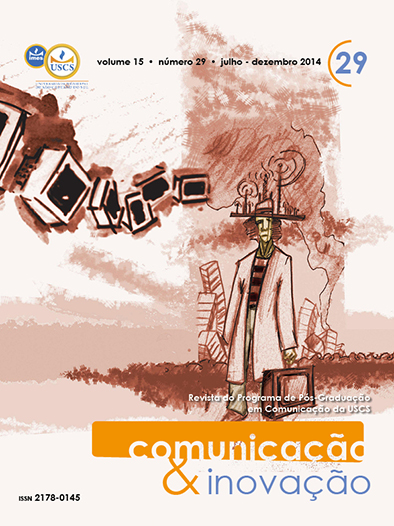Análise visual do Twitter
DOI:
https://doi.org/10.13037/ci.vol15n29.2931Palavras-chave:
inovação, trecnologias digitais, Twitter], FolksonResumo
A mídia social tornou-se um canal muito importante de comunicação e interação para pessoas de todo o mundo e uma grande quantidade de conteúdo está sendo criado. Como resultado, o processo de análise de tal enorme quantidade de dados requer o suporte de ferramentas e técnicas de visualização. Este estudo est[a centrdoa nas relações entre as palavras postadas no Twitter, usando o princípio da Folksonomia para categorizar as palavras mais recorrentes como etiquetas (ou tags). Além disso, ele propõe um modelo visual baseado no princípio de atração física que tem como objetivo mostrar a maneira que as principais etiquetas estão correlacionadas. Os resultados indicam o potencial do Modelo Orbital, porque pode ser utilizado para representar a dinâmica das relações ao longo do tempo.Downloads
Referências
Becker, H., Naaman, M. & Gravano, L. (2011). "Beyond trending topics: real-world event identification on
Twitter". In: Proceedings of Fifth International AAAI Conference on Weblogs and Social Media.
Barcelona, p. 438-441.
Boguta, K. (2009). "Evolution of a revolution: visualizing millions of Iran tweets". ReadWriteWeb.
Retrieved June, 2012, from http://www.readwriteweb.com/archives/evolution_revolution_visualizing_millions_iran_tweets.php
Boyd, D. & Crawford, K. (2012). "Critical questions for big data". Information, Communication & Society,
15 (5), 662-679.
Cantadora, I., Konstas, I. & Josec, J. M. (2011). "Categorising social tags to improve folksonomia-based
recommendations". Web Semantics: Science, Services and Agents on the World Wide Web, 9,
1-15.
Chen, I.-X. & Yang, C.-Z. (2010). "Visualization of social networks". In: B. Furht (ed.). Handbook of
Social Network Technologies and Applications: Springer Science+Business Media.
Cheong, M. & Lee, V. C. S. (2010). "Twitmographics: learning the emergent properties of the Twitter community". In: From Sociology to Computing in Social Networks, 323-342: Springer-Verlag.
1_[Dos1].indd 20 06/11/14 16:44
21 Comunicação & Inovação, PPGCOM/USCS
v. 15, n. 29 (7-22) jul-dez 2014
Análise visual do Twitter
______. (2011). "A microblogging-based approach to terrorism informatics: exploration and chronicling
civilian sentiment and response to terrorism events via Twitter". Information Systems Frontiers,
13, 45-59.
Fleishman, J. (2009). "Mideast hanging on every text and tweet from Iran". Los Angeles Times. Retrieved
May, 2012, from http://articles.latimes.com/2009/jun/17/world/fg-iran-image17
Gilbert, E., Karahalios, K. & Sandvig, C. (2010). "The network in the garden: designing social media for
rural life". American Behavioral Scientist, 53(9), 1367-1388: SAGE Publications.
Go, A., Bhayani, R. & Huang, L. (2009). "Twitter sentiment classification using distant supervision".
Stanford University. Retrieved June, 2012, from http://www.stanford.edu/~alecmgo/papers/
TwitterDistantSupervision09.pdf
Goolsby, R. (2009). "Lifting elephants: Twitter and blogging in a global perspective". In: Social computing
and behavioral modeling: Springer-Verlag.
Gupta, M., Li, R., Yin, Z. & Han, J. (2011). "An overview of social tagging and applications". In: Aggarwal
, C. C. (ed.). Social Network Data Analytics: Springer Science+Business Media.
Highfield, T., Kirchhoff, L. & Nicolai, T. (2011). "Challenges of tracking topical discussion networks
online". Social Science Computer Review, 29(3), 340-353.
Himelboim, I., Hansen, D. & Bowser, A. (2012). "Playing in the same Twitter network. Information",
Communication & Society. DOI: 0.1080/1369118X.2012.706316.
Jansen, B. J., Zhang, M., Sobel, K. & Chowdury, A. (2009). "Micro-blogging as online word of mouth
branding". Conference on Human Factors in Computing Systems (CHI 2009) (pp. 3859-3864).
Boston, MA: ACM.
Java, A., Song, X., Finin, T. & Tseng, B. (2007). "Why we Twitter: understanding microblogging usage
and communities". In: Proceedings of the 9th WebKDD and 1st SNA-KDD 2007 workshop on Web
mining and social network analysis, pp. 56-65, 2007. Proceedings of the 9th WEBKDD and 1st
SNA-KDD 2007, (pp.118-138): San Jose, CA.
Jin, Y., Li, R., Wen, K., Gu, X. & Xiao, F. (2011). "Topic-based ranking in folksonomia via probabilistic
model". Artificial Intelligence Review, 36, 139-151.
Jungherr, A. (2009). "The DigiActive guide to Twitter for activism". Retrieved May, 2012, from http://
tinyurl.com/6tr2pfp
Kakali, C. & Papatheodorou, C. (2010). "Exploitation of folksonomies in subject analysis". Library &
Information Science Research, 32, 192-202.
Karpinski, R. (2009). Twitter tools. B to B, vol. 94, n. (2), 2009, pp. 15-20.
Kawano, Y., Kishimoto, Y. & Yonekura, T. (2011). "A Prototype of Attention Simulator on Twitter".
International Conference on Network-Based Information Systems. IEEE Computer Society.
Kim, H.-N., Rawashdeh, M., Alghamdi, A. & El Saddik, A. (2012). "Folksonomia-based personalized
search and ranking in social media services". Information Systems, 37, 61-76.
1_[Dos1].indd 21 06/11/14 16:44
22 Comunicação & Inovação, PPGCOM/USCS
v. 15, n. 29 (7-22) jul-dez 2014
Elias Estevão Goulart & Sidney Fels
Lin, J. & Dyer, C. (2010). Data-Intensive Text Processing with MapReduce. University of Maryland:
College Park.
Liu, B. (2010). "Sentiment analysis and subjectivity". In: Indurkhya, N & Damerau F. J. (Eds). Handbook
of Natural Language Processing (pp. 627-666). Boca Raton, FL: Chapman & Hall/CRC.
López-Juárez, P. & Olivas, J. A. (2011). "Intentional tags in folksonomia based ranking systems". The 2011
World Congress in Computer Science, Computer Engineering, and Applied Computing. Retrieved
June, 2012, from http://world-comp.org/p2011/ICA5049.pdf
Luo, X., Ouyang, Y. & Xiong, Z. (2012). "Improving neighborhood based Collaborative Filtering via integrated folksonomia information". Pattern Recognition Letters, 33, 263-270.
MerlesWorld. A Beginner's Guide to Using & Marketing with Twitter. Retrieved Disponível em: June, 2012,
from de http://www.merlesworld.com/e-books/Twitter_Fast_Start.pdf. Acesso em junho de 2012.
Naaman, M., Becker, H. & Gravano, L. (2011). "Hip and trendy: characterizing emerging trends on Twitter".
Journal of the American Society for Information Science and Technology, 62(5), 902-918.
Nicholls, J. (2012). "Everyday, everywhere: alcohol marketing and social media - current trends". Alcohol
and Alcoholism. DOI:10.1093/alcalc/ags043.
Pang, B. & Lee, L. (2008). "Opinion mining and sentiment analysis". Foundations and Trends in Information
Retrieval, 2 (1), 1-135.
Ran, Z. & Erpeng, J. (2011). "Folksonomia - based library information organization in China". International
Conference on Business Management and Electronic Information (BMEI), 5, 270-272.
Romero, D. M., Meeder, B. & Kleinberg, J. (2011). "Differences in the mechanics of information diffusion
across topics: idioms, political hashtags, and complex contagion on Twitter". International World
Wide Web Conference (WWW 2011): India.
Schmitz,C., Hotho, A., Jaschke, R. & Stumme, G. (2006). "Mining association rules in folksonomies". In:
Data Science and Classification: Proceedings of the 10th IFCS Conference (pp. 261-270), Studies
in Classification, Data Analysis, and Knowledge Organization: Springer.
Shearman, S. (2012). "Twitter's branded venture". Marketing, 10-11.
Skold, M. (2008). Social network visualization. Master Thesis. Royal Institute of Technology: Sweden.
Thelwall, M., Buckley, K. & Paltoglou, G. (2011). "Sentiment in Twitter events". Journal of the American
Society for Information Science and Technology, 62(2), 406-418.
Tsytsauru, M. & Palpanas, T. (2012). "Survey on mining subjective data on the web". Data Mining and
Knowledge Discovery, 24(3), 478-514.
Wilson, V. "Research methods: content analysis". Evidence Based Library and Information Practice, 6(4),
177-179.
Zhang, L., Ghosh, R., Dekhil, M., Hsu, M. & Liu, B. (2011). "Combining lexicon based and learning-based
methods for twitter sentiment analysis". Technical Report HPL-2011-89: HP.
Downloads
Publicado
Edição
Seção
Licença
Direitos autorais (c) 2014 Elias Estevao Goulart, Sidney Fels

Este trabalho está licenciado sob uma licença Creative Commons Attribution-NonCommercial-NoDerivatives 4.0 International License.
Conforme consta nas normas da revista, o envio de artigos e textos solicitando a apreciação com a finalidade de publicação na Comunicação & Inovação, configura a cessão de direitos autorais.
No caso de fotos e imagens, o autor deve providenciar documento que ateste a permissão em termos de direitos autorais.





